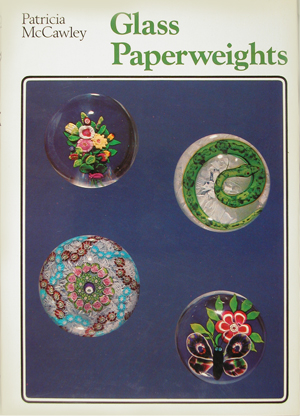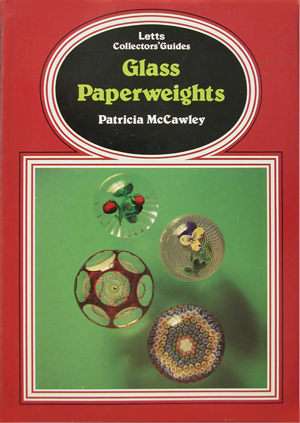Glass Paperweights
by: Patricia McCawley
1975, Charles Letts and Company Limited, London, England
and a 1982 revised edition with same content, and a new dust jacket.
72 pages, $20. hardcover
flyleaf “An aura of mystery and fascination has surrounded glass making from the earliest times: a legend accounts for its discovery; the 12th-century Venetians guarded the secret of its manufacture under the pain of death; and, until the middle of the nineteenth century, rewards were being offered to whoever could discover the secret of coloured glassware, known only to the Bohemians.
The technique of making millefiori or 1000 flower paperweights, with their innumerable small glass canes, said to have been created first in 1845, was lost, too, at the end of that century, and not discovered—even by the factories that made them—until 1958. For the collector, this means that paperweights devide into antique—those made by the three great French factories of Saint-Louis, Baccarat, and Clichy in the 19th century (although sulphide or medallion paperweights were made in the 18th century)—and the finer of the modern—made in France, England, Scotland, and the US.
Today, paperweights are made by hand and the process, absorbing to follow, differs very little from that used on the 19th century for both the millefiori and the flower and fruit subjects weights.
The examples illustrated in this section are representative of the variety of the finest weights, antique and modern, and, together with the diagrams of canes and cuttings, and the descriptions of the various factories, their colour and design preferences, will help any collector in the appreciation and identification of paperweights needed in building up a collection.
Patricia McCawley runs the paperweight department at Spink’s, the antique dealers. She travels extensively, advising collectors and museums, attending conventions and auction sales, buying and selling. She is the author of Antique Glass Paperweights from France.”
A good, simple introduction to the art of fine paperweights. It is nicely illustrated in color and black & white, representing a good cross section of weights including some rare masterpieces. Also included are a number of good line drawings which are helpful in identifying canes and cutting patterns used by the various makers in the classic period.


